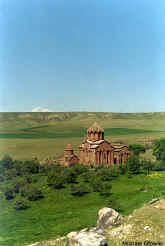|

|
At
the far end of
Vahramaberd
(12-13th c.
church in village), the next village, turn left, then follow the
dirt road back along the gorge and then descend (right fork) to
Marmashen
monastery. This
impressive monastic complex sits on a
picturesque shelf with
fruit trees above the Akhurian River, beside a stream that
ends in a waterfall.
The Katoghike church of |
|
The
main road continues N (in doubt take the right fork) to Kaps. |
UNDER
CONSTRUCTION
|
|
S. Stepanos was built by Vahram Pahlavuni,
whose gravestone sits in the ruined gavit, between 988 and 1029.
The gavit itself is 13th c.
There is an Astvatsatsin church, and a S. Petros, and
archaeologists found remnants of a fourth, nearly circular
church, along with foundations of a pre-Christian temple and
many service buildings. The complex was ruined by the Seljuks, and rebuilt by Vahramís
grandsons. On the
hill N is a cemetery with a ruined
chapel.
There is a bridge probably of the 10-11th c.
on the Akhurian nearby. Across
the river, near an abandoned medieval
settlement, are Bronze Age
graves. Retracing
steps up to the rim of the gorge and continuing S on the dirt
road skirting the gorge, one sees a basalt knob and scarp WNW of
Marmashen village. Descending
a few feet into the gorge, one finds about 40 meters NW of the
power lines a perfectly preserved Urartian inscription of
Argishti I (786-764
BC) carved into the basalt. Above
it are sparse ruins of an Urartian
stronghold.
|
|
|